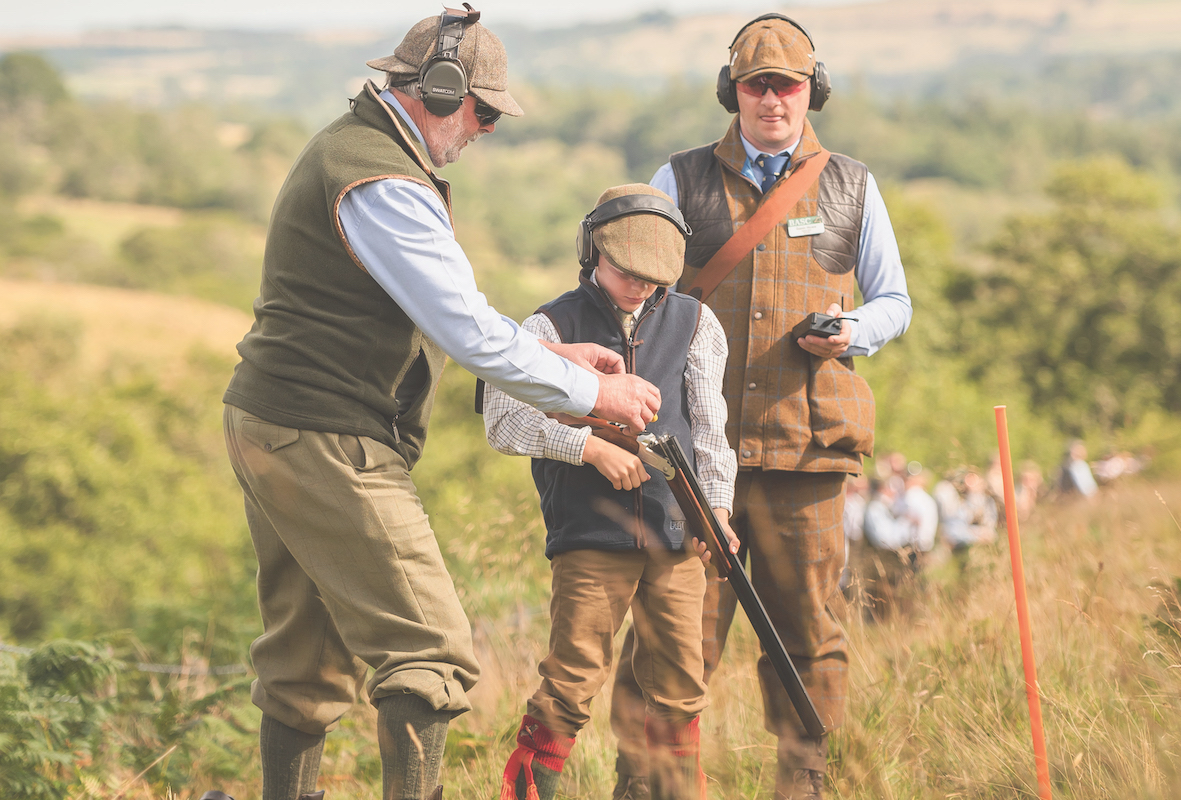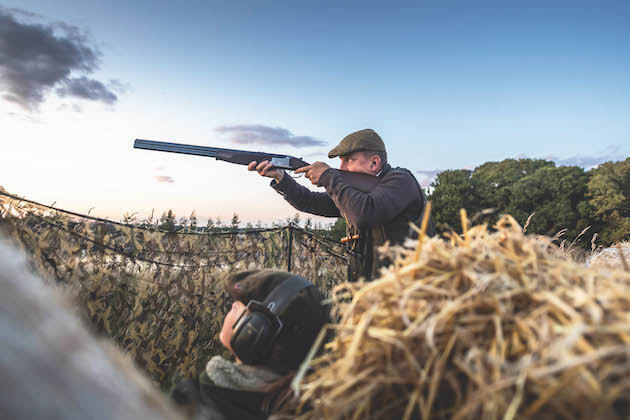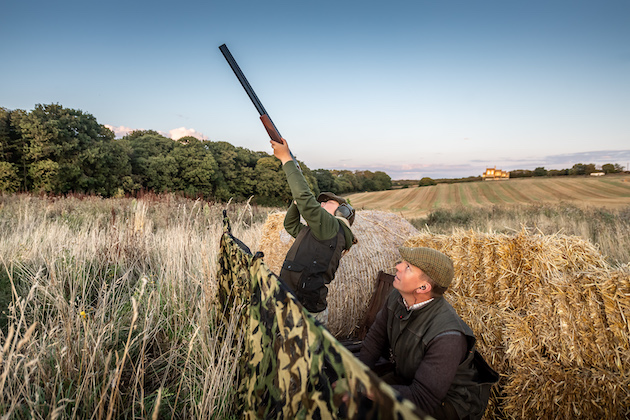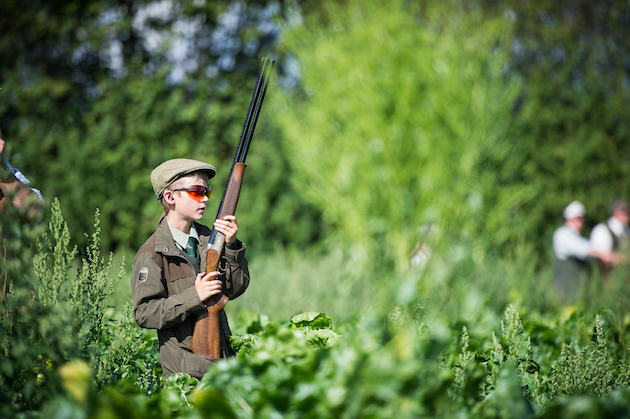BASC Young Shots shine on a day to remember
Alasdair Mitchell gets a rare glimpse into the future and is impressed with what he sees as BASC hosts 20 junior Guns in Northumberland

Despite the strong sun, Christopher Boynton's shooting is impressive
A BASC Young Shots day
The partridges came whirring over at all heights and from several directions, looking like a swarm of bees against the blue sky. There were so many that it must have been confusing for any seasoned Gun, let alone a novice.
There were excited yelps from some of the onlookers as more and more birds appeared. The 15-year-old boy in front of me shot two good birds in succession. Further down the line, I saw a 16-year-old girl dropping partridges in great style.
It’s not often that you can see the future, but I think I caught a glimpse of it on this BASC Young Shots day on the Whitfield Estate in Northumberland. When I was a boy, you tended to get into shooting only because somebody in your family shot. And unless you were born into the landed gentry, the chance of being allowed to enjoy a proper driven day was something you could only dream about for your adult years — if you were lucky.

Hannah Nelson shows some remarkable promise
Well, at Whitfield, I saw 20 boys and girls, all well dressed in shooting attire, enjoy a day’s shooting that they will always remember. These weren’t only partridges — they were Whitfield partridges. The estate is famous for the quality of its birds. Such excellence doesn’t come cheap, so it was all the more laudable that this BASC Young Shots day – a prime event – was free of charge to the participants.
Estate owner John Blackett-Ord and his wife, Sarah, donated the day, while BASC staff worked with legendary headkeeper Stuart Maughan and his team to run the event. Herds of BASC coaches and volunteers performed essential roles. Parents helped with beating and picking-up. Countryside Landowners Security helped with costs as part of its sponsorship of BASC’s regional Young Shots programme. (Read more on starting shooting.)
The day started with a bacon butty and coffee at The Elk’s Head, a friendly country pub on the Whitfield estate. After an introduction by Duncan Thomas, BASC’s northern regional director, there was a comprehensive briefing from regional officer Rob Newton.
The BASC young Shots were put into pairs. Each brace of youngsters was allocated to one adult. The chaperones would accompany their youngsters throughout the day, being responsible for safety, target selection and etiquette, as well as coaching on the peg.

Finn retrieves a redleg from the river
Young and old
The Guns were mainly teenagers, though the youngest, Christopher, was 10. Most of them used 12-bores and 20-bores. Eco-wadded steel ammunition was provided by BASC. Only a few of the youngsters had shot live quarry before — mainly pigeons or wildfowl. Some had never shot anything other than clays. (Read more on buying a first gun.)
The oldest participant was 87, in the form of BASC shotgun coach Peter Knox. Peter began shooting at the age of seven, in 1943. He qualified as a coach with the Clay Pigeon Shooting Association (CPSA) in 1966. He was given his first gun at the age of 10 and still uses it occasionally. He was one of the chaperones at Whitfield.
An interest in shooting is often handed down the generations, but it can also go the other way. I learned of one young lad from an urban area who got involved in BASC’s Young Shots programme and eventually applied for a shotgun certificate. After some initial reluctance from the police, he was successful. In the meantime, his father had become interested and is now part of the shooting community himself.
The morning session consisted of sporting clays in a realistic setting, with the pegs strung along the bottom of a defile cutting through upland grazing fields. The weather was ideal — dry, with a mixture of sun and clouds driven by an easterly breeze. When the clouds blotted out the sun, it felt cool. Although this was the first day of the partridge season, the scene was pleasantly autumnal, perhaps because we spent most of the day at an altitude of about 1,000ft.
Each youngster got in some useful practice on the clays, using about 75 cartridges each under the supervision of their chaperone. The session ended with a lengthy random flurry, which was great fun and allowed the teams of two to practise changeovers on their pegs. Then it was back in the vehicles and off down into woodland to lunch at an outdoor barbecue site, with game burgers and sausages aplenty courtesy of Ox Close Fine Foods. The event organisers were keen to ensure that the youngsters experienced the social side of shooting.
At the end of the lunch, the youngest of each pair of shooters came forward to pick a peg number. Then it was into the 4x4s and off up a rough, rocky track on to higher, open ground with spectacular views. The Guns lined out at 10 pegs spaced along a stream-bed gully littered with boulders.
Only sporadic patches of moving water were showing after the dry summer. Grassy banks clothed in patches of white grass, gorse and bracken loomed above.

A superb day ended with a demonstration of gun cleaning by Peter Knox
Perfect terrain
Whitfield’s terrain could have been specially designed to show gamebirds at an advantage. The fact that the estate has changed hands only once since the 12th century gives you an idea of the way they take the long term seriously here. The estate shoots over a total of 15,000 acres of remarkable landscape, officially designated an Area of Outstanding Natural Beauty, in south-west Northumberland.
Well-managed mixed woodland perched high above an incised river valley produces some of the most challenging driven pheasants in the country. As for partridges, the high grassland intersected by stream beds can show really strong-flying birds right from the start of the season. Higher up, the estate has 7,500 acres of highly productive grouse moor.
There were two successive partridge drives, each lasting nearly an hour. The birds just kept coming and they did unpredictable things that clays can’t — they accelerated, climbed, turned and curled. The challenge of picking a target out of a blizzard of birds is considerable, but this is where the chaperones come in. Is it a safe shot? An ethical one? Not surprisingly, people get excited when the sky is black with birds.

Wonderful country
Sixteen-year-old Amber, whom I watched smashing clays with great success in the morning, couldn’t manage to hit much on that first drive. Yet when I spoke to her after the second drive, she had started connecting, as evidenced by her broad grin. Thomas, aged 14, got three with his trusty .410.
The second drive went much the same as the first. Ben, aged 15, shot well and among his birds were two real screamers. Louis, aged 13, managed six. His 12-year-old team-mate, Jack, dropped five and was hoping to equalise when the horn blew. I had seen young Annabel swatting birds out of the sky. I later asked her how many she had got. “Enough,” she replied, wisely. She’ll go far.
The excited babble of voices at the end of the second drive included tales of who did what that will undoubtedly become part of family folklore. Once everything had been picked, we set off back down the roller-coaster track to the valley, returning to the lunch site. Here there were refreshments and demonstrations of gun cleaning and how to prepare a partridge carcass. It marked the end of a wonderful day of shared enthusiasm for old and young alike.

Stuart Maughan – Head Keeper at Whitfield
Stuart Maughan
In 1976, fresh out of Sparsholt College, Stuart Maughan knocked on the door of the then headkeeper at Whitfield. He was in luck — there was a vacancy for a trainee underkeeper. Today, Stuart heads a gamekeeping team of eight and is widely regarded as being at the top of his profession. Whitfield is famous for the quality of its driven birds, attracting repeat visits from some famous names. About 60% of Guns come from right across the UK, with the rest coming from continental Europe and North America.
BASC Young Shots organisation
Organising BASC Young Shots days is a lot of work, not least because of safety and parental consent. Phil Fairless, a chaperone on the Whitfield day, was instrumental in its success. A retired police officer, Phil is a volunteer and passionate about getting youngsters into shooting. He helped his grandson to reach national level in competitive clay shooting and has helped organise many BASC Young Shots events. He is a BASC-qualified coach and recently gave his 2,000th shooting lesson.








